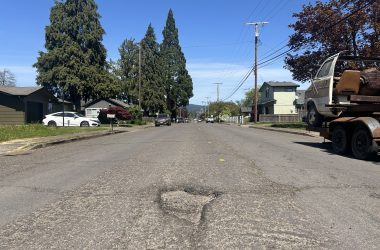Candidate overview: Geena Davis (Position 1) did not respond to requests for participation. She is running against Ken Kohl and Violet Olszyk. Heather Quaas-Annsa (Position 1) said that she is no longer actively campaigning, and is instead backing Ken Kohl for the position. Nicole De Graff and Anthony Reed are running for Position 4.
What can the board do to further improve career and college readiness for its students?
POSITION 1
KEN KOHL: The board needs to find more ways to engage students and keep them in school. Students won’t be ready for careers and college if they can’t finish high school. Qualified teachers and staff, career and technical education classes, advanced placement classes, and extra curricular activities all contribute to an environment that helps students be successful.
VIOLET OLSZYK: We need to get back to the basics. Graduation rates and proficiency levels are not where they should be. First and foremost we need to work harder to help every student be at a proficient reading level by 4th grade. I support our Career Technical Education program and will work to build on the success we’ve seen there. I think we need to be quick to drop what doesn’t work and to invest more into ideas that are yielding success.
POSITION 4
NICOLE DE GRAFF: Look at ways to continue to expand and educate families in CTE and dual enrollment programs. Promote apprenticeships with local businesses. Work with state officials on allocating funds. Reinstate requirements that will help students be able to start college at the appropriate level. Most importantly, focus on academic achievement above all.
ANTHONY REED: I believe that through expanded career and technical education we can improve our students’ workforce readiness. Making sure students have the basic skills they need to begin their journey beyond high school is one of my highest priorities. We should focus on building bridges to jobs through partnerships with local businesses and better preparing college bound students by increasing the number of advanced classes offered and improving our TAG programs to ensure our advanced students are being challenged and pushed to reach their full potential.
The Academy of Arts and Academics saw zero drop outs, with all 43 students having graduated in 2022. To what do you attribute this achievement to, and how can we mirror those methods in other high schools district-wide?
POSITION 1
KOHL: I believe this is an example of finding an approach that engages students. The Academy of Arts and Academics (A3) has a unique curriculum that appeals to a portion of the student body within the district. We need to find additional ways of engaging students and providing career skills, such as the cosmetology program the district will be adding next school year.
OLSZYK: As an arts major myself, this success is exciting to see. I think when students (and their parents) are empowered with the educational option that is right for them, they are more likely to succeed. We should continue to expand the set of tools available to parents that serve their children’s needs.
POSITION 4
DE GRAFF: Make sure we have appropriate pathways for all students. School choice and charter schools provide more opportunities for kids. Having alternatives like the Academy give parents and students the option to select the school that best serves them, giving them greater motivation and chance to succeed!
REED: A3 utilizes “project based learning” where the students get to pick their own projects in areas that interest them. They are put into groups with other students who have similar interests. This creates an environment of student lead learning where the students have a vested interest in what they are studying. That makes coming to school a lot more fun and interesting. Standardized testing has long been the standard for evaluating students, but as we see with A3, project based learning is a much better system and I would love to see it expand out into the other schools in the district.
What are among the most pressing mental and behavioral health needs of students and what can the board do to meet those needs?
POSITION 1
KOHL: This is a very important issue facing our students, however I wouldn’t presume to be an expert on mental and behavioral health in students, so I am not qualified to provide specific recommendations or comments. I think the board needs to seek and rely on expert advice and recommendations. This would include consultation with teachers, school counselors, and parents. Beyond evaluating the recommendations of experts, the board needs to ensure that there are sufficient funds allocated to mental health needs within the district.
OLSZYK: Bullying is top of my list. The most effective means of bullying prevention is to have programs that build relationships and understanding among students. I will push for positive bullying prevention programs that will build trust with students and keep children safe at school. We also need more mental health support in our schools to identify needs earlier before they become a crisis.
POSITION 4
DE GRAFF: Kids are still dealing with learning losses and mental health struggles due to Covid lock down policies. We need to make sure we provide adequate services and connect parents with community resources. I would be in support of partnering with the community to hold classes for parents on how to find family resources. Teachers need to be supported with behavior and other safety issues. Our School Resource Officer program goes a long ways towards providing that kind of backup to teachers and I support keeping it strong.
REED: Trauma. Our students are not only coming to school with trauma from their lived experiences, but some are experiencing trauma in school. I have heard terribly sad stories on the campaign trail about what some of our students are experiencing and that is why student safety is my top priority. As a board we can make a policy requiring school staff to be trained in trauma informed practices. This will better equip teachers and staff to handle behavior issues and support students where they are mentally and emotionally.
Local school boards have faced increasing pressure around curriculum changes. How can you and the board balance that demand?
POSITION 1
KOHL: The board needs to evaluate any curriculum changes based on the educational merit. It’s important that any changes to curriculum maintain a high academic standard and that all students feel welcome in the classroom. One example is the literacy curriculum incorporating more phonics into elementary education that has recently been proposed; Based on what I’ve read about this legislation. This curriculum appears to be based on the best available education research and is the type of change I would be supportive of.
OLSZYK: It takes collaboration between educational professionals and a student’s family to help a student achieve success. That is why I support publishing curriculums online to ensure transparency and foster trust. Parents must be part of the solution to problems children face in school both academically and socially. We have nothing to lose and everything to gain by engaging all parties in helping our students succeed!
POSITION 4
DE GRAFF: Make sure teachers and parents have a voice in choosing curriculum as well as making it transparent on the district’s website. Right now the process is cumbersome and inaccessible to working parents. We also need to educate the public on joining their site councils.
REED: My partner is a teacher. I have been there to witness many curriculum adoption processes and quite a process it is. I believe that our teachers and the district can and should be trusted in choosing and implementing new curriculum. To the candidates pushing for parents to have a role in curriculum adoption: I invite them to really take a deep dive into what it takes to choose, pilot and implement actual curriculum. There is a lot more to it than most people might imagine.
School safety is on the minds of many parents and students after the steady rise in gun violence across the nation. What can the board do to help keep students safe?
POSITION 1
KOHL: It’s unfortunate that our schools have had to implement security measures and policies due to the increased gun violence in our country. This is obviously an issue that our school district has experienced firsthand. In addition to the costs of these measures and policies, I feel this makes our schools a less welcoming environment, for our students, teachers, and as a hub of community activity.
OLSZYK: While I’m pleased with how safety and discipline is managed at my children’s school, I know that not all parents have the same experience. I will work hard to build on the quality already in place to ensure all families feel safe. I support our School Resource Program and will make sure it stays in place.
POSITION 4
DE GRAFF: Listen to staff and parents. We can continue to educate and investigate whether we have sufficient School Resource Officers in our district.
REED: As I said above, Student Safety is my number one priority. Keeping our students safe goes far beyond infrastructure and staff. As a board we will need to focus on improving and supporting our students’ mental health. We must identify students struggling with mental health before they get to the point they want to hurt themselves or others. That’s not to say staff and infrastructure are not important. Having staff that is trained to recognize threats and respond appropriately will always be crucial as well as infrastructure designed with safety in mind.








